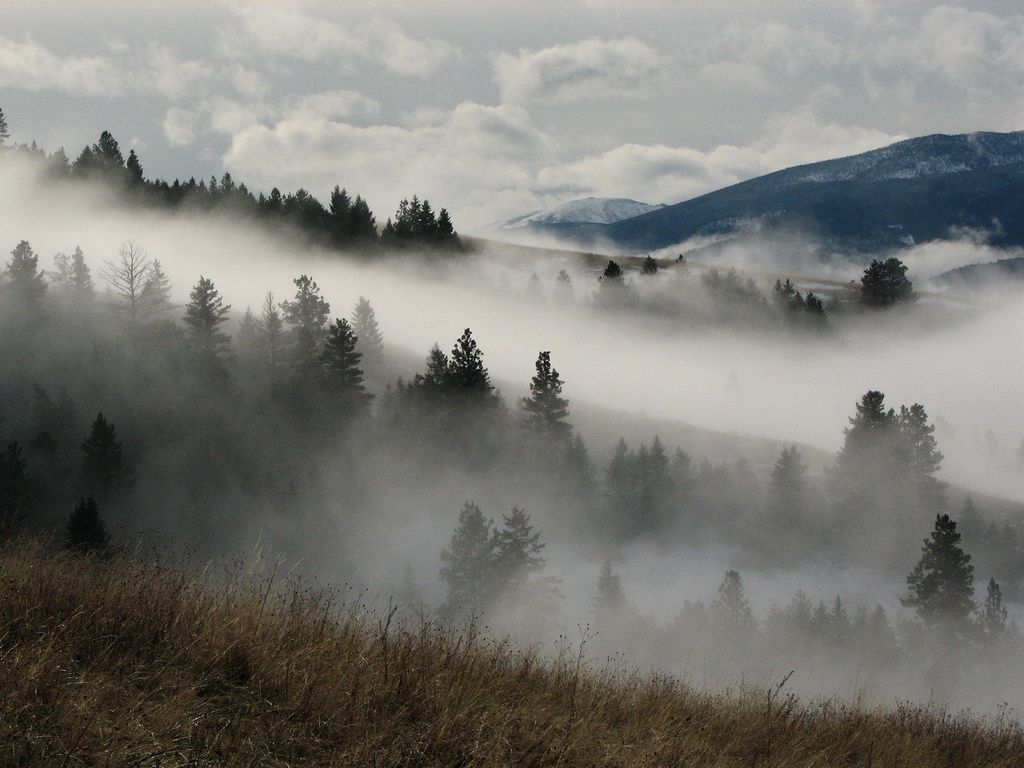Mountains shrouded in mysterious fog create some of nature’s most captivating spectacles, where advection fog transforms familiar peaks into ethereal landscapes that ignite human imagination.
🌫️ The Dance Between Mountains and Moving Mist
Advection fog represents one of nature’s most fascinating atmospheric phenomena, particularly when it encounters the dramatic topography of mountain ranges. Unlike radiation fog that forms through cooling, advection fog travels horizontally, carried by wind currents across landscapes until it meets the imposing barriers of mountainous terrain. This encounter creates spectacular visual displays and complex meteorological interactions that have captivated scientists, photographers, and mountain enthusiasts for generations.
The term “advection” originates from the Latin word “advectio,” meaning “carrying toward.” This perfectly describes how warm, moisture-laden air moves horizontally over cooler surfaces or into cooler regions, causing water vapor to condense into countless suspended droplets. When this process occurs near mountain ranges, the results become dramatically amplified, creating conditions that can transform visibility, temperature, and the entire character of alpine environments within minutes.
Understanding the Science Behind Advection Fog Formation
Advection fog develops when warm, humid air mass moves across a cooler surface, causing the temperature to drop below the dew point. This meteorological process differs fundamentally from other fog types because it requires horizontal air movement rather than vertical mixing or radiative cooling. The fog consists of microscopic water droplets suspended in the air, typically ranging from 10 to 20 micrometers in diameter.
Several critical conditions must align for advection fog to form effectively. First, there must be a temperature difference between the moving air mass and the surface below. Second, sufficient moisture content must exist within the air mass. Third, wind speeds need to fall within a specific range—typically between 5 and 15 knots—because too little wind prevents fog distribution while excessive wind disperses the fog entirely.
The Role of Temperature Inversions
Mountain environments frequently experience temperature inversions, where warmer air sits atop cooler air near the surface. These inversions create ideal conditions for advection fog persistence. When fog-laden air encounters mountains during inversion conditions, the fog can become trapped against slopes and in valleys, creating prolonged periods of reduced visibility that can last for days.
The stability provided by inversions prevents the fog from rising and dissipating. Instead, the fog layer maintains its position, flowing like a slow-motion river around mountain contours. This phenomenon explains why certain mountain regions experience persistent fog events while surrounding lowlands remain clear.
🏔️ How Mountain Topography Shapes Fog Behavior
Mountain terrain doesn’t simply intercept advection fog—it actively transforms and redirects it through various mechanical and thermodynamic processes. The interaction between horizontal fog movement and vertical mountain barriers creates phenomena that wouldn’t occur over flat terrain.
Orographic Lifting and Fog Enhancement
When advection fog encounters mountain slopes, orographic lifting forces the moist air upward along the mountainside. As the air rises, it expands and cools further, often intensifying the fog and potentially generating orographic precipitation. Windward slopes typically experience the densest fog concentrations, while leeward sides may experience entirely different conditions.
This lifting effect can transform a thin fog layer into a thick cloud bank that completely obscures mountain peaks. The process also explains why certain mountain faces consistently experience heavier fog than others, creating microclimates that influence local ecosystems, vegetation patterns, and wildlife behavior.
Fog Channeling Through Valleys and Passes
Mountain valleys and passes act as natural conduits for advection fog, channeling and accelerating fog movement through topographic constrictions. This channeling effect can increase local wind speeds and fog density, creating corridors of reduced visibility that pose challenges for transportation and aviation.
The Venturi effect intensifies as fog flows through narrow mountain gaps, similar to water accelerating through a constricted pipe. These fog rivers can persist for extended periods, particularly when large-scale weather patterns maintain steady flow conditions.
Geographic Hotspots for Mountain Advection Fog
Certain regions worldwide have become renowned for their spectacular displays of advection fog interacting with mountain terrain. These locations share common characteristics: proximity to large water bodies, significant elevation changes, and prevailing wind patterns that transport moist air toward mountains.
Coastal Mountain Ranges
The Pacific Coast of North America exemplifies ideal advection fog conditions. The Golden Gate Bridge in San Francisco regularly disappears beneath dense fog banks as marine air from the Pacific Ocean encounters the coastal hills. Similarly, the coastal mountains of Oregon and Washington experience frequent fog events when onshore winds push maritime air against the Cascade Range.
The interaction creates dramatic visual contrasts where fog blankets lower elevations while peaks remain visible above, creating the appearance of islands floating in a sea of white. These conditions have inspired countless photographs and artworks celebrating the mystical beauty of fog-shrouded landscapes.
Monsoon-Influenced Mountain Systems
The Himalayas and Western Ghats in India experience extraordinary advection fog during monsoon seasons. Moisture-laden winds from the Indian Ocean transport enormous quantities of water vapor inland, where it encounters these massive mountain barriers. The resulting fog and cloud formations contribute significantly to regional water cycles and support unique cloud forest ecosystems.
These mountain systems receive some of the highest rainfall totals on Earth, partly due to the continuous interaction between advection fog, orographic lifting, and sustained moisture transport. The fog doesn’t merely pass through—it deposits moisture directly onto vegetation through fog drip, a process that can contribute more water to ecosystems than measured rainfall.
⚡ Ecological Impacts of Mountain Fog Systems
Advection fog interactions with mountains create distinct ecological zones that support specialized plant and animal communities. These fog-dependent ecosystems demonstrate remarkable adaptations to life within persistent mist and reduced sunlight.
Cloud Forest Ecosystems
Cloud forests represent perhaps the most dramatic ecological expression of mountain fog interactions. These forests exist within the persistent fog zone where advection fog regularly bathes vegetation in moisture. Trees in these environments often display stunted growth patterns, twisted forms, and extensive epiphyte coverage, including mosses, lichens, and bromeliads that harvest moisture directly from fog.
The constant moisture availability allows cloud forests to support biodiversity levels comparable to tropical rainforests despite occurring at higher, cooler elevations. Many species found in these environments exist nowhere else on Earth, having evolved specifically to exploit fog-derived moisture.
Fog as a Water Resource
In semi-arid mountain regions, advection fog represents a critical water source for both natural ecosystems and human communities. Specialized collection systems can harvest fog water for drinking, irrigation, and other uses. Countries including Chile, Peru, and Morocco have implemented fog collection projects in mountainous areas where conventional water sources remain scarce.
Natural fog harvesting by vegetation can contribute substantial water volumes to watersheds. Studies have documented fog drip contributions ranging from 10% to over 80% of total water input in some ecosystems, highlighting the critical importance of these interactions for regional hydrology.
🌍 Climate Change and Shifting Fog Patterns
Global climate change is altering advection fog patterns worldwide, with significant implications for mountain ecosystems and human communities. Research indicates that fog frequency has declined in many regions over recent decades, while other areas experience changes in fog timing, duration, and altitude distribution.
Warming ocean temperatures affect the temperature gradients necessary for advection fog formation. Simultaneously, changing wind patterns alter moisture transport routes, potentially shifting fog zones to different elevations or regions entirely. These changes threaten fog-dependent ecosystems and the unique species they support.
Monitoring and Prediction Challenges
Accurately forecasting advection fog in mountainous terrain remains challenging despite advances in meteorological science. The complex interactions between topography, wind patterns, temperature gradients, and moisture availability create highly localized conditions that can vary dramatically over short distances.
Modern weather models increasingly incorporate high-resolution topographic data to better simulate fog behavior in mountain environments. Satellite imagery, ground-based sensors, and machine learning algorithms are improving forecast accuracy, though significant uncertainty remains, particularly for fog onset, dissipation timing, and spatial distribution.
🎨 Cultural and Aesthetic Significance
Throughout human history, fog-shrouded mountains have inspired artistic expression, spiritual traditions, and cultural narratives. The mystical quality of mountains emerging from and disappearing into fog has captivated human imagination across cultures and continents.
Artistic Representations
Traditional Chinese landscape painting frequently depicts mountains partially obscured by mist, using fog as both an aesthetic element and a philosophical symbol representing the unknowable and transcendent. Japanese art similarly employs fog and clouds to create depth, mystery, and emotional resonance in mountain landscapes.
Contemporary photography has embraced mountain fog as a subject, with images of fog-filled valleys, fog waterfalls, and fog inversions becoming iconic representations of natural beauty. Social media platforms have amplified interest in these phenomena, with specific locations becoming destinations for photographers seeking to capture these ephemeral moments.
Spiritual and Mythological Connections
Many cultures associate fog-covered mountains with spiritual significance, viewing them as dwelling places of deities, ancestors, or supernatural forces. The obscuring quality of fog enhances mountains’ mysterious nature, suggesting hidden realms beyond human perception.
This spiritual dimension continues to influence how people experience and value fog-shrouded mountain landscapes, contributing to conservation efforts and tourism development in regions known for spectacular fog displays.
Safety Considerations and Practical Implications
While beautiful, advection fog in mountain environments creates genuine hazards for travelers, aviators, and outdoor enthusiasts. Reduced visibility can disorient even experienced mountaineers, while rapidly changing conditions can trap individuals in dangerous situations.
Navigation and Wayfinding
Dense fog eliminates visual landmarks that travelers typically rely upon for navigation. Combined with mountain terrain’s inherent dangers—cliffs, crevasses, unstable slopes—fog-induced disorientation has contributed to countless accidents and rescues.
Modern GPS technology provides reliable positioning even in zero visibility, but cannot warn of immediate hazards or changing terrain conditions. Understanding fog behavior patterns helps outdoor enthusiasts make informed decisions about when to proceed, when to shelter, and when to retreat.
Aviation and Mountain Fog
Mountain wave phenomena associated with advection fog create significant aviation hazards, including turbulence, icing, and visibility restrictions. Pilots operating in mountainous regions must understand how fog interacts with terrain to anticipate dangerous conditions.
Mountain airports frequently experience fog-related delays and cancellations, particularly in coastal ranges where marine fog regularly penetrates inland. Advanced instrument approach systems have improved safety, but mountain fog continues to challenge aviation operations worldwide.
🔬 Research Frontiers and Future Understanding
Scientific understanding of advection fog interactions with mountain terrain continues to evolve. Emerging research areas include detailed microphysical processes within fog droplets, complex fluid dynamics of fog flow around irregular terrain, and long-term ecological consequences of changing fog patterns.
Advanced instrumentation now allows researchers to study fog at unprecedented scales, from individual droplet behavior to regional circulation patterns. Unmanned aerial vehicles equipped with specialized sensors can collect data within fog layers previously inaccessible, revealing new insights into fog structure and behavior.
Interdisciplinary Approaches
Understanding mountain advection fog requires integrating knowledge from meteorology, ecology, hydrology, and geomorphology. Collaborative research projects increasingly bring together specialists from these disciplines to develop comprehensive models of fog systems and their broader environmental roles.
This interdisciplinary approach recognizes that fog represents more than a weather phenomenon—it constitutes a critical component of mountain environments that influences water cycles, ecosystem function, geomorphological processes, and human activities.
🌟 Embracing the Mystery and Majesty
The interaction between advection fog and mountain terrain creates some of Earth’s most enigmatic and beautiful natural phenomena. These encounters transform familiar landscapes into otherworldly environments where visibility shrinks to meters, sounds become muffled, and the ordinary becomes extraordinary.
Understanding the science behind these interactions deepens appreciation rather than diminishing wonder. Knowledge of temperature gradients, moisture transport, and orographic effects enhances our ability to anticipate, experience, and protect these remarkable manifestations of atmospheric and topographic interplay.
As climate patterns shift and human impacts on mountain environments intensify, maintaining healthy fog-dependent ecosystems becomes increasingly important. The mystical mountains emerging from enigmatic fog remind us of nature’s complexity and the interconnections between atmosphere, terrain, and life itself.
Whether viewed from a scientific perspective, appreciated for aesthetic beauty, or experienced firsthand during mountain adventures, advection fog interactions with mountain terrain exemplify the dynamic processes that shape our planet. These phenomena will continue to captivate future generations, inviting exploration, study, and wonder at the remarkable world we inhabit.
Toni Santos is a visual storyteller and artisan whose creations celebrate the poetry of the natural world. Through his thoughtful artistic lens, Toni captures the elegance of botanical forms, transforming them into meaningful expressions of symbolism, resilience, and timeless beauty.
His journey is deeply rooted in a passion for flora and the mysteries they carry. From the shape of a petal to the curve of a vine, each design Toni brings to life reflects a deeper narrative — one of growth, transformation, and harmony with nature. Whether crafting symbolic floral jewelry, enchanted botanical illustrations, or seasonal visual studies, Toni’s work evokes the quiet magic found in Earth’s most delicate details.
With a background in handcrafted artistry and visual design, Toni blends technique with intention. His creations do more than decorate — they speak, often inspired by ancient meanings behind flowers, the cycles of the seasons, and the invisible bonds between nature and spirit.
As the creative voice behind Vizovex, Toni shares this botanical journey with the world, offering curated stories, handcrafted collections, and thoughtful articles that help others reconnect with nature’s symbolism and artistic essence.
His work is a tribute to:
The quiet power of flowers and their messages
The art of visual symbolism in everyday life
The beauty of slowing down to see what’s hidden in plain sight
Whether you’re an artist, a nature lover, or someone drawn to the deeper meanings behind the natural world, Toni welcomes you to explore a space where aesthetics meet soul — one petal, one story, one creation at a time.





